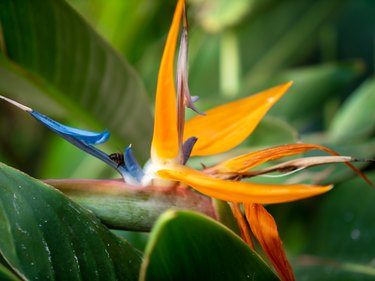
The exotic, brightly colored flowers of the bird of paradise (Strelitzia reginae), hardy in U.S. Department of Agriculture plant hardiness zones 9 through 12, are just one of the ways that the plant has adapted to its environment. Bird of paradise adaptations range from the blossoms that resemble a bird's head to the mildly toxic fruits and seeds that prevent wildlife from consuming the plant's reproductive parts.
About Bird of Paradise
Video of the Day
Bird of paradise, also known as crane flower and bird's tongue flower, is a native of South Africa. The 3- to 5-foot-tall clumps of gray-green leaves and flower stems rise from rhizomes. Each leaf grows up to 6 inches wide and 18 inches long.
Video of the Day
Often grown in pots on the patio and taken indoors when outdoor temperatures drop toward freezing at night, these tropical beauties can tolerate short periods at 24 degrees Fahrenheit, but the flower buds and flowers are affected by freezing temperatures. A wind-sheltered location against a south-facing wall that receives full sun provides a warmer microclimate in USDA zone 9, though frosts may affect the plant. If planted outside, mulch heavily and cover them with a frost blanket or dig up smaller plants and move them indoors for the winter.
Bird of paradise prefers a well-drained, moist soil and temperatures ranging down to 55 to 65 degrees at night and 75 degrees during the day. Place the flowerpots in full sun or partial shade or a brightly lit location indoors to ensure flowering. Each plant can produce up to 36 flower spikes per year.
Rhizome Root Systems
Rhizomes are actually horizontal stems that grow underground. From the rhizome, roots extend into the soil to extract moisture and nutrients, and the plant's leaves and flower stalks grow upward to absorb the sun's rays and produce flowers and seeds. The relatively shallow rhizomes and roots are well-adapted to the moist conditions of its natural habitat along waterways.
Most plants that grow from rhizomes, like the bird of paradise, can be divided when the clump becomes too crowded. Carefully dig up the clump or remove it from the flowerpot in late spring or early summer and tease the roots and rhizomes apart. Cut the rhizomes apart with a knife sterilized in rubbing alcohol, leaving at least one "eye" or stem and a few roots per section. Replant in fresh potting soil or in a warm, sheltered location outside. Keep them evenly moist but not waterlogged until the plants are firmly established in their new home.
Bird of Paradise Flowers
The bright-orange flowers of the bird of paradise appear from the spathe, which is the green-gray base that grows at a right angle to the flower stem. It looks like a bird's head. The three orange sepals are the protective and supportive outer structures of the flower. The three blue petals are the actual blossom, where nectar and pollen are produced.
The nectar is located between two of the blue petals. When birds land on the flower to drink the nectar, the petals open and release pollen to cover the birds' feet. The birds move from flower to flower and spread the pollen from one plant to the next.
You can hand-pollinate your bird of paradise if you'd like to try to grow the seeds but be warned – the seeds require five months to mature. Once planted, the seeds germinate in two to three months if kept continuously moist. Seedlings flower in three to five years.
Bird of Paradise Adaptations and Toxicity
Among the bird of paradise adaptations is the mild toxicity of the plant, particularly the fruits and seeds. Ingesting the plant causes nausea, vomiting and drowsiness in humans, cats, dogs and horses. This discourages wildlife from grazing on the leaves and eating the fruits and seeds. Though the bird of paradise is generally not fatal, other plants commonly known as bird of paradise are more toxic.
Use caution when planting a bird of paradise shrub (Poinciana gilliesii), also known as pride of Barbados and peacock flower, or other toxic plants in the garden. Though beautiful and hardy in USDA zones 8 through 11, the leaves and seeds of this lovely shrub or small tree cause oral irritation, drooling, vomiting and other gastric distress as well as incoordination in pets.
- UCCE Master Gardeners: Yet Another Installment of Road Trip Musings...
- North Carolina Extension Gardener Plant Toolbox: Strelitzia reginae
- University of Florida IFAS Extension: Bird-of-Paradise
- Wisconsin Horticulture Division of Extension: Bird of Paradise, Strelitzia reginae
- American Society for the Prevention of Cruelty to Animals: Bird of Paradise Flower
- Pet Poison Helpline: Poinciana